Authentic German Rouladen
This post may contain affiliate links. See my disclosure policy.
One of Germany’s most famous and delicious dishes, Rouladen (Rinderrouladen) are beef roulades filled with bacon, onions, mustard and pickles, then browned and simmered in the richest gravy imaginable. Mouthwateringly delicious and made the way my Mutti and Oma made it, this authentic Rouladen recipe is the only one you’ll ever need!
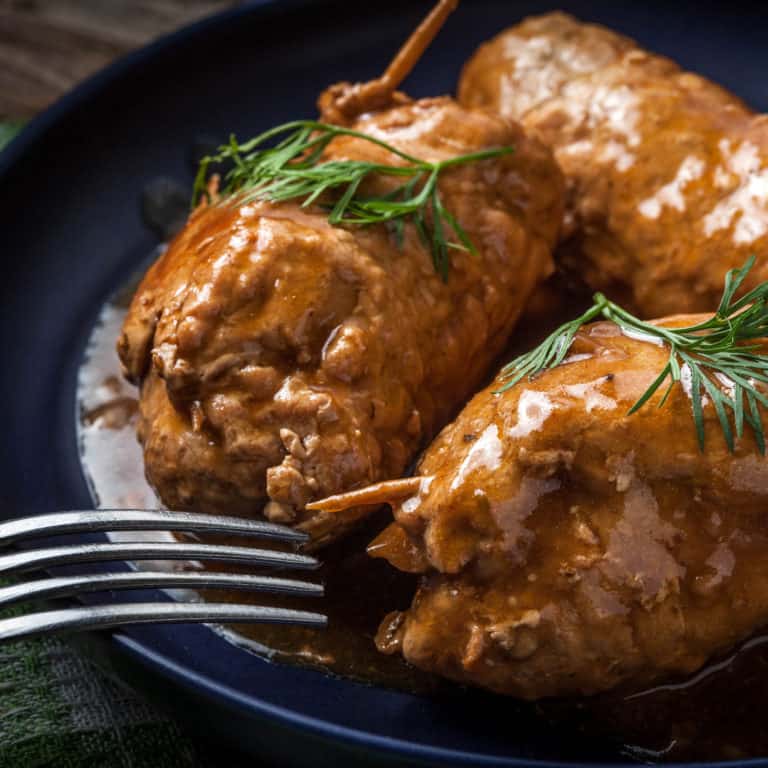
The BEST Rouladen Recipe
Growing up in Stuttgart, we regularly enjoyed family dinners with my Oma and Opa. My Oma was famous for her Kasseler, Kartoffelpuffer, Sauerbraten and her Rinderrouladen (beef roulades). When a meal included gravy she always knew to make extra when we came over because I would heap copious amounts of it over my meat, potatoes, Semmelknödel, Kartoffelklöße, Rotkohl, Sauerkraut, you name it. (I still do.) For me the gravy was one of the primary highlights of the meal. Rouladen is one of my all-time favorite German dishes and its accompanying gravy is arguably the king of all gravies. Today I’m sharing my homemade Rouladen recipe with you and I’m confident you’re going to love it as much as we do!
What is Rouladen?
Rouladen is a traditional German dish featuring long, thin strips of meat slathered with mustard and filled with bacon, onions, and pickles. The filling is enclosed by rolling up the meat strips and the roulades are then browned and slow-simmered in a rich gravy.
Beef rouladen are enjoyed throughout the year in Germany but are often associated with Sunday dinners and special occasions like Christmas Eve.
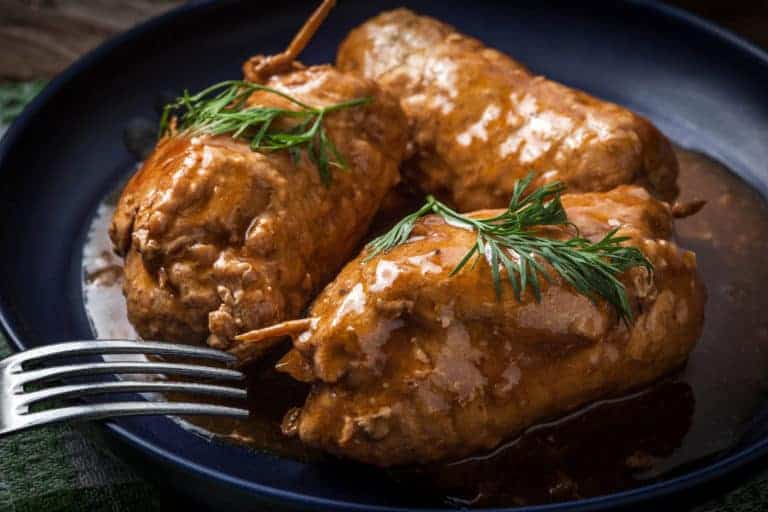
Rouladen Recipe
Rouladen aren’t hard to make, but they do take time. You can shave off some time on the day of your meal by assembling the rouladen ahead of time and chilling them until you’re ready to cook them.
Rouladen are made by spreading some German mustard on thinly cut slices of beef, adding bacon, sliced German pickles and chopped onions. Sprinkle with some salt and pepper and roll them up, securing the rolls with toothpicks or cooking twine. Next you generously fry the rouladen in oil until they’re nicely browned on all sides. They’re then removed and set aside so you can saute the onions and vegetables for the gravy. Add the liquids and spices to the cooked veggies and nestle the rouladen in this mixture to simmer on low until the meat is fork tender. The rouladen are removed, the sauce is poured through a strainer, and the resulting gravy is returned to the pot and thickened. The rouladen are returned to the gravy, heated through and served with Rotkohl and boiled potatoes, Knödel, or Spätzle.
Below I’ve provided step-by-step pictured instructions to ensure your success!

Prepare the slices of beef. They need to be large enough to stuff and roll up, at least 4×6 inches in size and about 1/4 inch thick. This recipe makes 2 rouladen per person. Alternatively you can make larger rouladen and serve one large rouladen per person.
Lay the beef slices out on a work surface. Spread each beef slices with about 2 teaspoons of German mustard and sprinkle with a little salt and freshly ground black pepper.
Place a strip of bacon on each beef slice so it’s running the same length as the beef. Place the sliced German pickles and chopped onions on each beef slice.
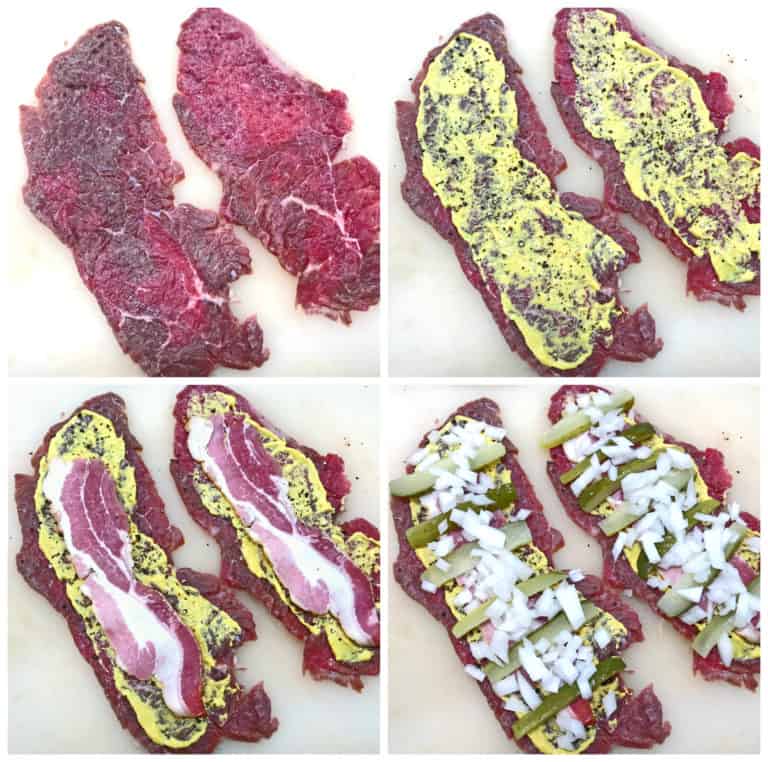
Roll up the beef slices, tucking in the sides as best you can and securing the beef rolls with toothpicks or cooking twine.

Heat the butter and oil in a heavy Dutch oven or pot (make sure it’s oven-safe if baking in the oven) and generously brown the rouladen on all sides. Browning them well will ensure a rich and flavorful gravy. Set the rouladen aside on a plate.
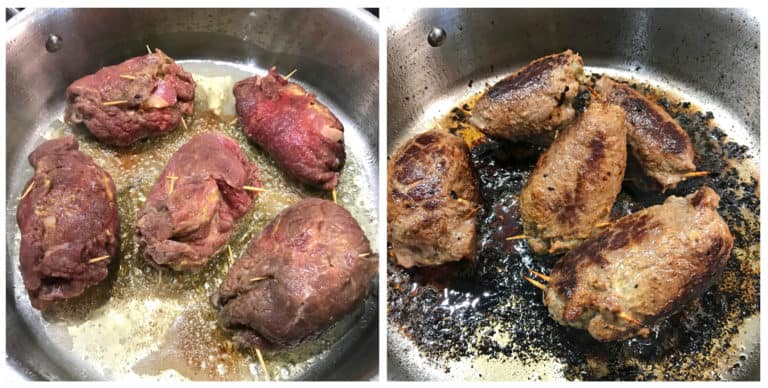
*Do not remove the browned bits in the bottom of the pan, it’s key to the most flavorful gravy!
Add the onions to the pot and a little more butter or oil if needed. Cook the onions until softened and translucent, about 5 minutes. Add the garlic and cook for another minute. Add the leek, carrots and celery and cook for another 5 minutes. Pour in the red wine, bring to a rapid boil for one minute, reduce the heat to medium and simmer for 2-3 more minutes.
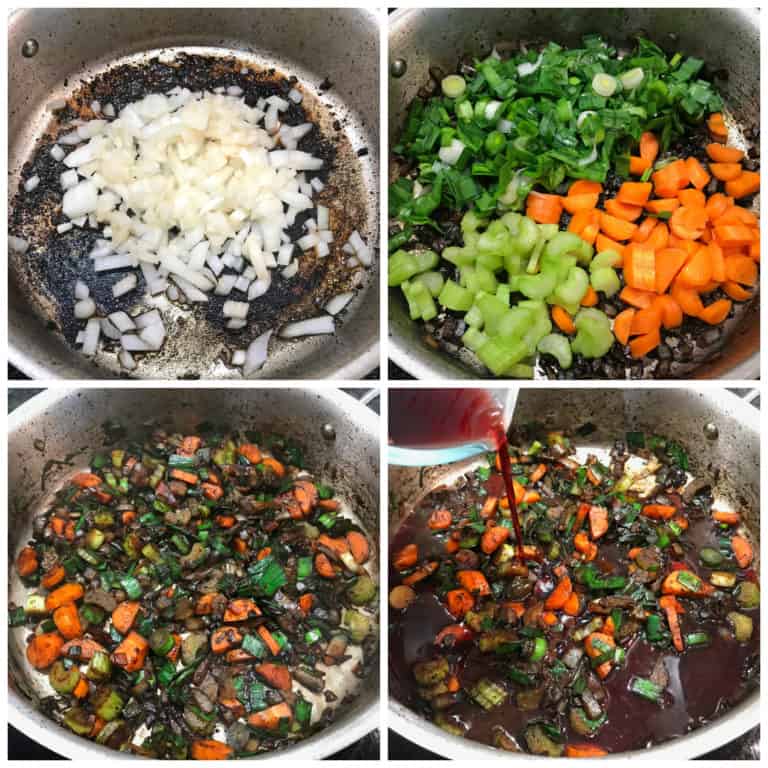
Add the beef broth, tomato paste, bay leaf, salt and pepper. Nestle the rouladen in the pot.
Oven or Stovetop: You can cook the rouladen, covered, on the stovetop on low for about 90 minutes or until fork tender but for the most even cooking we recommend transferring the pot (make sure it’s oven-safe) to the oven preheated to 325 F and cook it there for about 90 minutes or until fork tender.
To Make the Rouladen Gravy:
When the beef is fork tender, remove the rouladen from the pot and set aside. Pour the liquid and vegetables through a strainer and reserve the liquid. (You can set the veggies aside for another purpose, they are yummy. Or you can puree the veggies in the blender and then return them to the gravy.)

Return the strained liquid back to the pot and bring to a simmer. Thicken the gravy either with either a cornstarch slurry (for a clear/translucent gravy) or flour slurry (for an opaque gravy). For a creamy gravy you can also add a few tablespoons of heavy cream at this point. Simmer, whisking constantly, until the gravy is thickened.
Add the chilled butter, whisking constantly, until the butter is melted and incorporated. Add salt, pepper and mustard to taste. Note: If you’d like creamy gravy you can stir in some heavy cream at this point.
Carefully remove the toothpicks or cooking twine from the rouladen and return them to the gravy and heat through.
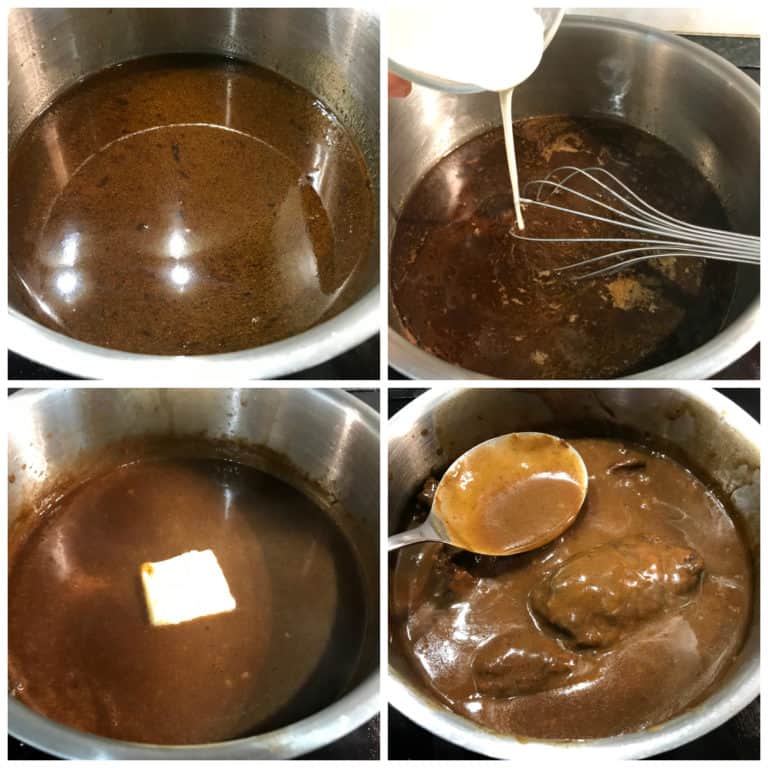
Can Rouladen Be Made Ahead Of Time?
You can save time by assembling the rouladen in advance and chilling them until you’re ready to cook them. They are also good reheated.
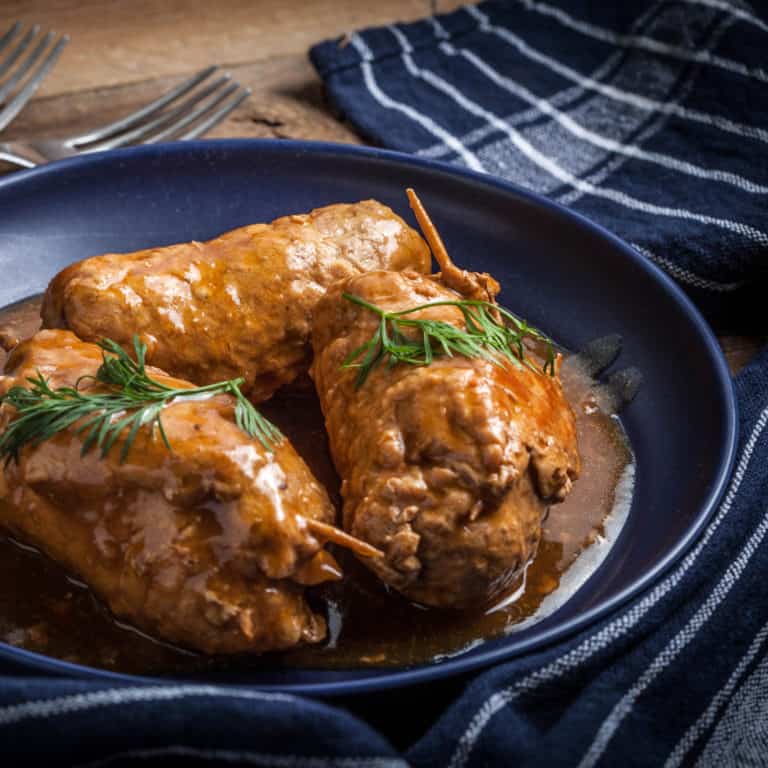
What to Serve With Rouladen
You can pair your Rouladen with any number and variety of sides much like you would a beef roast. Here are some traditional German sides you can pair with your Rinderrouladen:
- Rotkohl (German Red Cabbage)
- Spätzle (German Noodles)
- Semmelknödel (German Bread Dumplings)
- Kartoffelklöße (German Potato Dumplings)
- Kartoffelpuffer (German Potato Pancakes)
- German Potato Salad (Kartoffelsalat)
- Creamy German Cucumber Salad (Gurkensalat)
- Bohnensalat (German Green Bean Salad)
- German Carrot Salad (Karottensalat)

For more authentic German dishes try my:
- Sauerbraten
- Königsberger Klopse
- Käsespätzle
- German Potato Salad
- Senfbraten
- Schnitzel
- Jägerschnitzel
- Schweinshaxe
- Maultaschen
- German Potato Soup
- Frikadellen
Save This Recipe
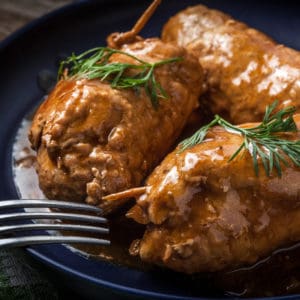
Authentic German Rouladen
Equipment
Ingredients
- For the Rouladen:
- 8 slices top round beef, about 4×6 inches in size and 1/4 inch thick (*see note) (ask your butcher), gently pound the slices with a meat mallet until they're a little thinner than 1/4 inch (be careful not to pound holes into them)
- 1/3 cup German yellow mustard
- 8 slices bacon
- 8 medium German pickles , sliced lengthwise
- 1 medium yellow onion , chopped
- salt and freshly ground black pepper
- For the Gravy:
- 1 tablespoon butter
- 1 tablespoon cooking oil (I use avocado oil because it's ideal for high heat)
- 1 medium yellow onion , chopped
- 1 clove garlic , minced
- 1 small leek , chopped, rinsed and drained in colander
- 1 large carrot , chopped
- 1 large celery stalk , chopped
- 1 cup dry red wine
- 2 cups strong beef broth
- 1 tablespoon tomato paste
- 1 bay leaf
- 1 teaspoon sugar
- 1/2 teaspoon salt
- 1/4 teaspoon freshly ground black pepper
- 4 tablespoons chilled butter
- cornstarch or flour dissolved in a little water for thickening (depending on how much gravy liquid there is you'll need about 1-2 tablespoons of cornstarch dissolved in 2-3 tablespoons of water or 2-3 tablespoons flour dissolved in 1/4 – 1/3 cup water)
Instructions
- Lay the beef slices out on a work surface. Spread each beef slices with about 2 teaspoons of mustard and sprinkle with a little salt and freshly ground black pepper. Place a strip of bacon on each beef slice so it's running the same length as the beef. Place the sliced German pickles and chopped onions on each beef slice. Roll up the beef slices, tucking in the sides as best you can and securing the beef rolls with toothpicks or cooking twine.
- Heat the butter and oil in a heavy Dutch oven or pot (make sure it's oven-safe if baking in the oven) and generously brown the rouladen on all sides. Browning them well will ensure a rich and flavorful gravy. Set the rouladen aside on a plate.
- *Do not remove the browned bits in the bottom of the pan (important for a flavorful gravy): Add the onions to the pot and a little more butter or oil if needed. Cook the onions until softened and translucent, about 5 minutes. Add the garlic and cook for another minute. Add the leek, carrots and celery and cook for another 5 minutes. Pour in the red wine, bring to a rapid boil for one minute, reduce the heat to medium and simmer for 2-3 more minutes. Add the beef broth, tomato paste, bay leaf, sugar, salt and pepper.
- Nestle the beef rouladen in the pot. Oven or Stovetop: You can cook the rouladen, covered, on the stovetop on low for about 90 minutes or until fork tender, but for the most even cooking we recommend transferring the pot (make sure it's oven-safe) to the oven preheated to 325 F and cook it there for about 90 minutes or until fork tender.
- To Make the Rouladen Gravy:When the beef is fork tender, remove the rouladen from the pot and set aside. Pour the liquid and vegetables through a strainer and reserve the liquid. (You can eat the veggies on the side or puree them in the blender and then return them to the gravy.) Return the strained liquid back to the pot and bring to a simmer. Thicken the gravy either with either a cornstarch slurry (for a clear/translucent gravy) or flour slurry (for an opaque gravy). For a creamy gravy you can also add a few tablespoons of heavy cream at this point. Simmer, whisking constantly, until the gravy is thickened.Add the chilled butter, whisking constantly, until the butter is melted and incorporated. Add salt, pepper and mustard to taste. Note: If you prefer a creamy gravy you can stir in some heavy cream.Carefully remove the toothpicks or cooking twine from the rouladen and return them to the gravy and heat through.
- Serve the rouladen and gravy with Homemade Rotkohl and either Homemade Spätzle, Homemade SemmelKnödel (or Kartoffelknödel) or boiled potatoes.
Notes
- This recipe makes 2 rouladen per person. Alternatively you can make larger rouladen for one large rouladen per person.
Nutrition
Originally published on The Daring Gourmet October 29, 2019



















I love this recipe. My mom used to make this on special occasions, but she would use a lil bit of sour cream at the end. Added more richness a a bit of tang. Personal preference, I’m sure, but it was fabulous!
This recipe knocked my socks off!
Nice and simple, a little time consuming, but so worth it!
Thank you, Jason, I’m so glad you enjoyed it!
My son says this rouladen is now his favorite food ever. He is 32 and requests it for every holiday. The sauce can’t be beat. The meat is so tender. The pickles and alstertor rmustard (used Kruegermann pickles the last 2 times) really make the experience a flavorful wonder. Thanks for giving such detailed instructions. I serve it with Spaetzel and rot Kohl. Best dinner ever.
Thank you so much, Andrea, I’m happy this has become a family favorite!
I made the recipe as written but the sauce was so fatty after cooking, I drained the veg and refrigerated the cooking liquid to draw all of the fat to the top so I could skim it. Then I used the blender to incorporate the veg into the defatted sauce and reheated the rouladen in the defatted sauce and pureed veg. It was delicious. This is a time consuming and labor intensive recipe but if you have the time, it is well worth the effort
1)I have Grey Poupon Mustard and Haendlemaier Bavarian Mustard. can I use either one of them?
2)Rouladen meat is hard to find. what kind of beef should I look for? Flank steak appears kind of tough.
thank you.
Hi Astrid, neither mustard will give your Rouladen the right flavor. If I had to choose between the two I would choose Grey Poupon over the Bavarian mustard, but I would go with honestly go with regular American yellow mustard before choosing either of those. For the beef cuts I recommend using top round. Most butchers know what Rouladen cuts are (though I’ve had some who “thought” they knew and they were totally off!) but if they don’t you can request 8 slices of top round that are roughly 4×6 inches in size and just slightly less than 1/4 inch thick.
The recipe calls for 8 slices of beef, says it makes 8 servings, but the notes and nutrition information say there are 2 rouladen per serving. So are these quantities really for 4 servings? I just want to make sure I’m making enough for my dinner.
Hi Doreen, yes it’s 2 rouladen per serving for a total of 4 servings. Sorry for the confusion.
Making this now…in the oven in a Dutch oven. Should it be covered?
Hi Diane, yes, keep it covered. Happy cooking! :)
Traditional food items everywhere vary from family to family, and I like trying new variations. This recipe is quite good, and while I still like Oma’s better, I was happy with the results.
I would like to make a couple of clarifications for other who may try this. “German Pickles” are sometimes called barrel pickles here. You can make your own with this recipe: https ://skipthejunk. com/2018/01/10/german-style-pickles/
I am curious if you use mittelscharfer or scharfer mustard. I used scharfer, but I like hot mustard.
Thanks again for this great recipe.
Hi Bob, thanks for the feedback. I use mittelscharfer, my personal preference.
I’m making rouladen today, brings back such good memories of living in Germany in the late 50s when our German housekeeper would cook for us. By the way, she is still living in the Bronx in New York, we keep in touch regularly and visit occasionally. I have let her know that I am making this, she will probably be very envious. The one difference I see is that she used something called sour pickles. Occasionally I could find them, but no longer.